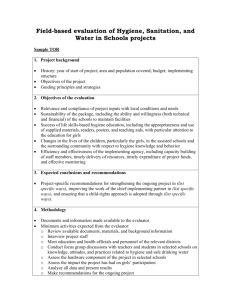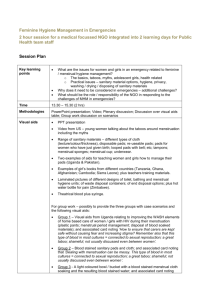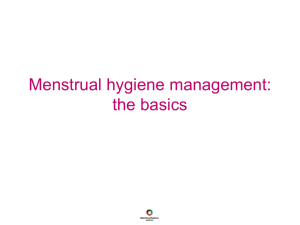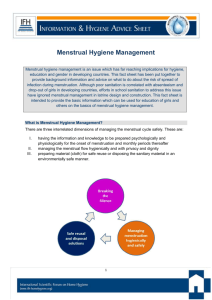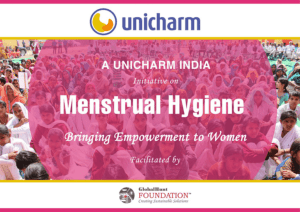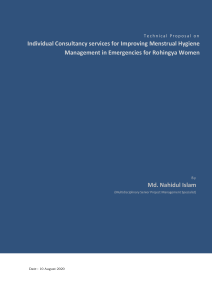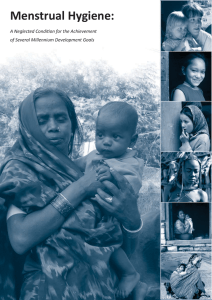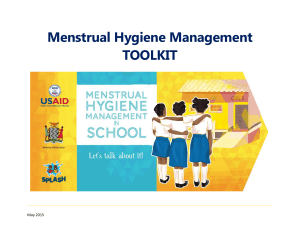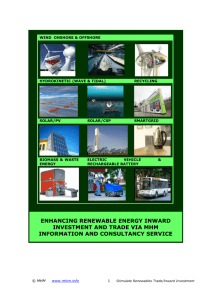WASH in Schools for Girls: Menstrual Hygiene Management Fact
advertisement
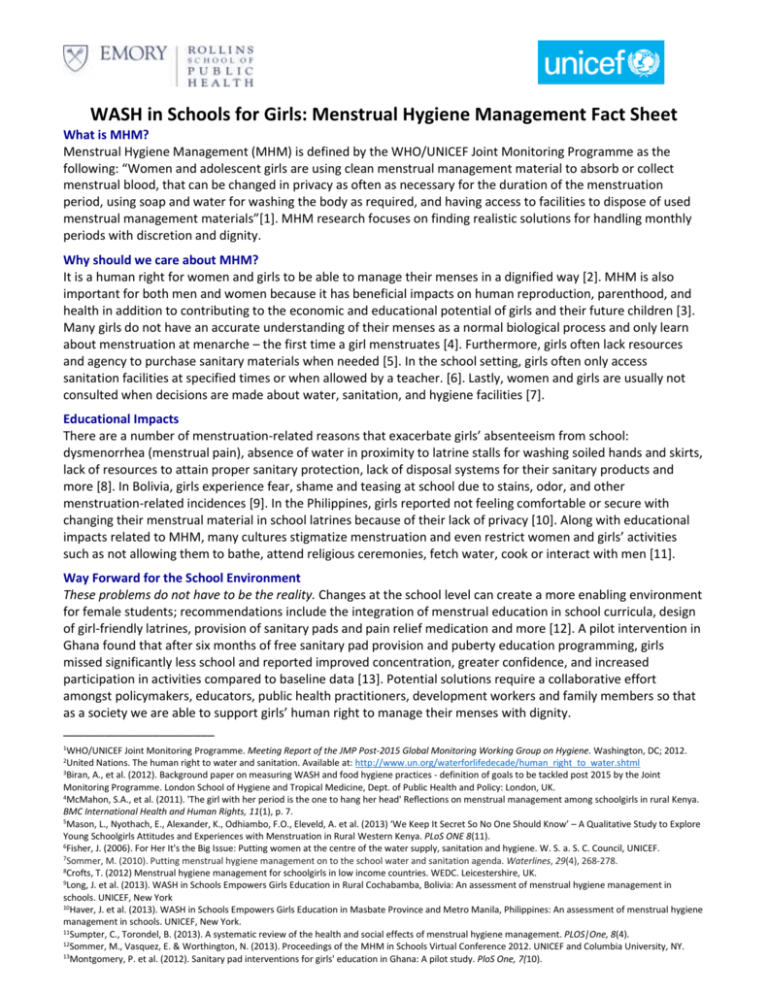
WASH in Schools for Girls: Menstrual Hygiene Management Fact Sheet What is MHM? Menstrual Hygiene Management (MHM) is defined by the WHO/UNICEF Joint Monitoring Programme as the following: “Women and adolescent girls are using clean menstrual management material to absorb or collect menstrual blood, that can be changed in privacy as often as necessary for the duration of the menstruation period, using soap and water for washing the body as required, and having access to facilities to dispose of used menstrual management materials”[1]. MHM research focuses on finding realistic solutions for handling monthly periods with discretion and dignity. Why should we care about MHM? It is a human right for women and girls to be able to manage their menses in a dignified way [2]. MHM is also important for both men and women because it has beneficial impacts on human reproduction, parenthood, and health in addition to contributing to the economic and educational potential of girls and their future children [3]. Many girls do not have an accurate understanding of their menses as a normal biological process and only learn about menstruation at menarche – the first time a girl menstruates [4]. Furthermore, girls often lack resources and agency to purchase sanitary materials when needed [5]. In the school setting, girls often only access sanitation facilities at specified times or when allowed by a teacher. [6]. Lastly, women and girls are usually not consulted when decisions are made about water, sanitation, and hygiene facilities [7]. Educational Impacts There are a number of menstruation-related reasons that exacerbate girls’ absenteeism from school: dysmenorrhea (menstrual pain), absence of water in proximity to latrine stalls for washing soiled hands and skirts, lack of resources to attain proper sanitary protection, lack of disposal systems for their sanitary products and more [8]. In Bolivia, girls experience fear, shame and teasing at school due to stains, odor, and other menstruation-related incidences [9]. In the Philippines, girls reported not feeling comfortable or secure with changing their menstrual material in school latrines because of their lack of privacy [10]. Along with educational impacts related to MHM, many cultures stigmatize menstruation and even restrict women and girls’ activities such as not allowing them to bathe, attend religious ceremonies, fetch water, cook or interact with men [11]. Way Forward for the School Environment These problems do not have to be the reality. Changes at the school level can create a more enabling environment for female students; recommendations include the integration of menstrual education in school curricula, design of girl-friendly latrines, provision of sanitary pads and pain relief medication and more [12]. A pilot intervention in Ghana found that after six months of free sanitary pad provision and puberty education programming, girls missed significantly less school and reported improved concentration, greater confidence, and increased participation in activities compared to baseline data [13]. Potential solutions require a collaborative effort amongst policymakers, educators, public health practitioners, development workers and family members so that as a society we are able to support girls’ human right to manage their menses with dignity. ______________________ 1WHO/UNICEF Joint Monitoring Programme. Meeting Report of the JMP Post-2015 Global Monitoring Working Group on Hygiene. Washington, DC; 2012. Nations. The human right to water and sanitation. Available at: http://www.un.org/waterforlifedecade/human_right_to_water.shtml 3Biran, A., et al. (2012). Background paper on measuring WASH and food hygiene practices - definition of goals to be tackled post 2015 by the Joint Monitoring Programme. London School of Hygiene and Tropical Medicine, Dept. of Public Health and Policy: London, UK. 4McMahon, S.A., et al. (2011). 'The girl with her period is the one to hang her head' Reflections on menstrual management among schoolgirls in rural Kenya. BMC International Health and Human Rights, 11(1), p. 7. 5Mason, L., Nyothach, E., Alexander, K., Odhiambo, F.O., Eleveld, A. et al. (2013) ‘We Keep It Secret So No One Should Know’ – A Qualitative Study to Explore Young Schoolgirls Attitudes and Experiences with Menstruation in Rural Western Kenya. PLoS ONE 8(11). 6 Fisher, J. (2006). For Her It's the Big Issue: Putting women at the centre of the water supply, sanitation and hygiene. W. S. a. S. C. Council, UNICEF. 7Sommer, M. (2010). Putting menstrual hygiene management on to the school water and sanitation agenda. Waterlines, 29(4), 268-278. 8Crofts, T. (2012) Menstrual hygiene management for schoolgirls in low income countries. WEDC. Leicestershire, UK. 9Long, J. et al. (2013). WASH in Schools Empowers Girls Education in Rural Cochabamba, Bolivia: An assessment of menstrual hygiene management in schools. UNICEF, New York 10Haver, J. et al. (2013). WASH in Schools Empowers Girls Education in Masbate Province and Metro Manila, Philippines: An assessment of menstrual hygiene management in schools. UNICEF, New York. 11Sumpter, C., Torondel, B. (2013). A systematic review of the health and social effects of menstrual hygiene management. PLOS|One, 8(4). 12 Sommer, M., Vasquez, E. & Worthington, N. (2013). Proceedings of the MHM in Schools Virtual Conference 2012. UNICEF and Columbia University, NY. 13Montgomery, P. et al. (2012). Sanitary pad interventions for girls' education in Ghana: A pilot study. PloS One, 7(10). 2United

